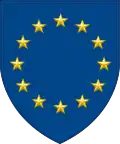Argentina–European Union relations
Comparison Table
| Population | 510,056,011[1] | 44,938,712 |
| Area | 4,324,782 km2 (1,669,808 sq mi)[2] | 2,780,400 km2 (1,073,500 sq mi) |
| Population Density | 115/km2 (300 /sq mi) | 14.4/km2 (37.3/sq mi) |
| Capital | Brussels (de facto) | Buenos Aires |
| Global Cities | Paris, Rome, Berlin, Vienna, Madrid, Amsterdam, Athens, Helsinki, Warsaw, Lisbon, Prague, Nicosia, Stockholm, Bucharest, Copenhagen, Budapest, Bratislava, Ljubljana, Zagreb, Sofia etc. | Buenos Aires, Santa Fe, San Juan, La Rioja, Santiago del Estero, Viedma, Río Gallegos, San Salvador de Jujuy, Mendoza, Paraná, San Luis, Santa Rosa, San Fernando del Valle de Catamarca, Corrientes, San Miguel de Tucumán, Rosario, Formosa, Mar del Plata, Río Cuarto, La Pampa, San Carlos Minas, Villa Fontana, San Javier, Las Heras |
| Government | Supranational parliamentary democracy based on the European treaties[3] | Federal presidential constitutional republic |
| First Leader | High Authority President Jean Monnet | President Bartolomé Mitre |
| Current Leader | Council President Charles Michel Commission President Ursula von der Leyen |
President Alberto Fernández |
| Current Vice Leader | Vice Commission President Frans Timmermans | Vice President Cristina Fernández de Kirchner |
| Official languages | 24 official languages, of which 3 considered "procedural" (English, French and German)[4] | Spanish |
| Main Religions | 72% Christianity (48% Roman Catholicism, 12% Protestantism, 8% Eastern Orthodoxy, 4% Other Christianity), 23% non-Religious, 3% Other, 2% Islam |
62.9% Roman Catholic, 18.9% Irreligious, 15.3% Evangelicalism, 1.4% Jehovah's Witnesses and Mormon, 1.2% Other, 0.3% Unknown |
| Ethnic groups | Germans (ca. 80 million), French (ca. 67 million), British (ca. 60 million), Italians (ca. 60 million), Spanish (ca. 47 million), Poles (ca. 46 million), Romanians (ca. 16 million), Dutch (ca. 13 million), Greeks (ca. 11 million), Portuguese (ca. 11 million), and others |
96.7% European, and Mestizo (mostly Italian and Spanish descent), 2.4% Amerindian, 0.5% Asian, 0.4% African, 62.5% Italian, 37.5% Non-Italian |
| GDP (nominal) | $16.477 trillion ($31,801 per capita) | $445.469 billion ($9,887 per capita) |
Agreements
Argentina was the first Latin American country to formalize relations with the EU under a 3rd generation cooperation agreement. The Framework Trade and Economic Co-operation Agreement between the EU and Argentina entered into force in 1990 and includes two recurrent principles of their cooperation: the strengthening of democracy and human rights, as well as regional integration. An EU-Argentina Joint Commission has also been established. A number of sectoral agreements were established in the 1990s. The main focuses of cooperation are education and training; economic competitiveness; capacity‑building in the public and academic sectors.[5]
Argentina is part of the EU's negotiating with the regional bloc Mercosur for a free trade agreement which will form the back bone of EU-Latin American relations.[6] However, during the 2000s and early 2010s the Kirchner administration developed a protectionist policy and stalled negotiations for a free trade agreement. Mauricio Macri restarted the process in his first months as president.
In 2016, the French government has asked to delay negotiations for a free trade agreement to carry an impact study, which was supported by several European countries. Others like Spain and Italy have asked for immediate negotiations.
Trade
The EU is Argentina's second largest export market (after Brazil). Argentina's exports to the EU are mainly agricultural and other primary goods. The EU exports less goods to Argentina in return (giving the EU a deficit of €3.4 billion) but has a surplus in services of €0.4 billion. The EU is also Argentina's biggest foreign investor, accounting for half of Argentina's foreign direct investment (FDI).[6]
| EU – Argentina trade in 2008[6] | ||||
|---|---|---|---|---|
| Direction of trade | Goods | Services | Investment flow | Investment stocks |
| EU to Argentina | €4.8 billion | €2.4 billion | €4.4 billion | €44.1 billion |
| Argentina to EU | €8.2 billion | €2.0 billion | €0.3 billion | €1.7 billion |
References
- "Eurostat-Tables,Graphs and Maps Interface(TGM)table". European Commission. Retrieved 9 March 2015.
- "Field Listing – Area". The World Factbook. Central Intelligence Agency. Retrieved 9 March 2015.
- "Archived copy". Archived from the original on January 21, 2015. Retrieved 2015-01-21.CS1 maint: archived copy as title (link)
- "European Commission - PRESS RELEASES - Press release - Frequently asked questions on languages in Europe". europa.eu. Retrieved 2017-06-24.
- Republic of Argentina, European External Action Service
- Bilateral relations Argentina, European Commission
External links
- EU delegation to Argentina (English)


